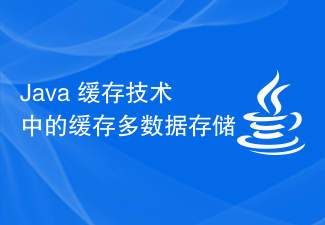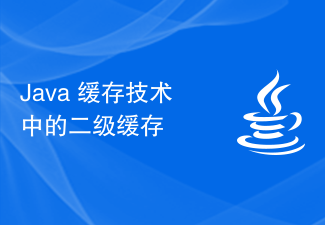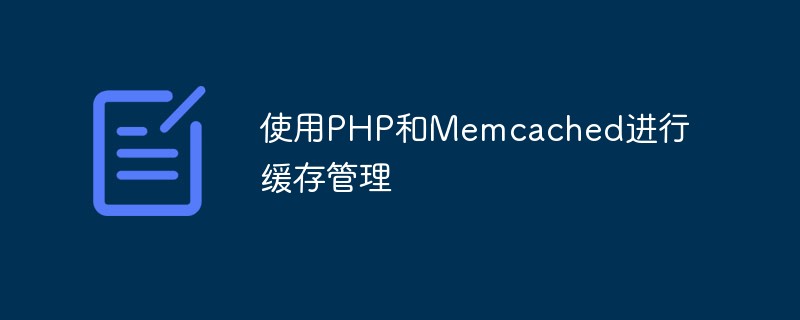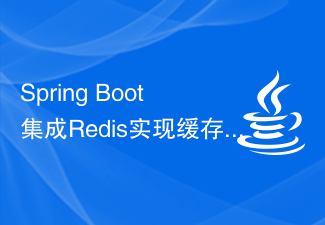With the continuous development of Internet technology, Java caching technology has been widely used in web applications. Caching technology can greatly improve the running speed of web applications, reduce network delays, and relieve server pressure. However, during development, we often encounter the problem that the cache is not updated or the cached data expires. The cache release mechanism is a very important link in caching technology. This article will introduce the cache release mechanism in Java caching technology and how to ensure the accuracy of the cache.
1. Cache release mechanism
The cache release mechanism refers to a mechanism whereby certain data in the cache cannot be accessed or deleted within a certain period of time. This is to avoid caching dirty data. of accumulation. The commonly used cache release mechanisms in Java caching technology include the following two types:
1. Time expiration mechanism
The time expiration mechanism means that cached data will automatically expire after being stored for a certain period of time and cannot If accessed again, the cache data needs to be updated again. Time expiration is the most basic one of the cache release mechanisms and the most commonly used one.
The time expiration mechanism is widely used in applications. It can be used for user login status caching, verification code caching, etc. The time expiration mechanism allows the data in the cache to be automatically updated according to application requirements, ensuring the accuracy of the cached data to a certain extent.
2. Reference counting mechanism
The reference counting mechanism means that one or some data in the cache depends on other cached data. When the number of references to the cached data is 0, the cached data will be lifted. The reference counting mechanism is also called the dependency cache release mechanism.
The main application scenario of the reference counting mechanism in applications is that there is a dependency relationship between cached data, such as a dependency relationship between the user information cache and the approval information cache. Using the reference counting mechanism can avoid cyclic dependencies between cached data and ensure the security and integrity of cached data.
2. Ways to ensure cache accuracy
Caching technology is widely used in applications, but the accuracy of cached data also needs to be guaranteed, otherwise caching technology will lose its application value. In order to ensure the accuracy of cached data, Java caching technology provides the following two methods.
1. Type safety mechanism
The type safety mechanism ensures the accuracy of cached data through the data types of the Java language. When using caching technology, you need to ensure that the type of cached data is consistent with the data type in the application. This is the type safety mechanism.
Through the type safety mechanism, data errors caused by inconsistencies between the cached data type and the data type in the application can be avoided. During development, you can use data type enumerations or class libraries to unify cached data types and check the data types when getting or setting cached data, thereby improving the stability of the program.
2. Monitoring mechanism
The monitoring mechanism refers to ensuring the accuracy of cached data by monitoring changes in cached data. In Java caching technology, a monitoring mechanism can be used to monitor data changes and update the cached data according to actual needs.
The monitoring mechanism can solve problems such as cache data expiration and cache data update, thereby ensuring the accuracy of cache data. In practical applications, the monitoring mechanism can be used together with the time expiration mechanism and the reference counting mechanism to improve the reliability of cached data.
3. Summary
The cache release mechanism in Java cache technology is very important and plays a vital role in applications. The time expiration mechanism and the reference counting mechanism are two commonly used cache release mechanisms. In order to ensure the accuracy of cached data, it is recommended to use type safety mechanisms and monitoring mechanisms. To sum up, in order to ensure the accuracy and real-time performance of the cached data and improve the stability of the program, the cache release mechanism and guarantee method need to be reasonably selected.
The above is the detailed content of Cache release mechanism in Java caching technology. For more information, please follow other related articles on the PHP Chinese website!
 vue的keep-alive组件如何优化图片加载体验Jul 22, 2023 am 08:09 AM
vue的keep-alive组件如何优化图片加载体验Jul 22, 2023 am 08:09 AMVue是一种流行的JavaScript框架,可以帮助我们构建交互式的Web应用程序。在开发过程中,我们常常遇到需要加载大量图片的情况,而这往往会导致页面加载速度变慢,影响用户体验。本文将介绍如何利用Vue的keep-alive组件来优化图片的加载体验。为什么需要优化图片加载体验?图片在网页中扮演着非常重要的角色,可以增加网页的吸引力和可读性,提升用户体验。然
 Java 缓存技术中的缓存多数据存储Jun 19, 2023 pm 11:34 PM
Java 缓存技术中的缓存多数据存储Jun 19, 2023 pm 11:34 PM随着互联网应用的不断发展,数据量急剧增加,如何高效地读写数据成为了每个开发人员都需要面对的问题。而缓存技术正是解决这个问题的重要方法之一。而在Java缓存技术中,缓存多数据存储是一种常见的技术手段。一、什么是缓存多数据存储?缓存多数据存储是一种多级缓存机制,将缓存按照使用频率、数据大小、数据类型等因素进行分层存储,以提高缓存的存取效率。一般情况下,缓存数据分
 Java 缓存技术中的二级缓存Jun 20, 2023 pm 12:51 PM
Java 缓存技术中的二级缓存Jun 20, 2023 pm 12:51 PM随着互联网的普及和信息化进程的加速,数据量呈现爆发式增长,使得我们在开发过程中遇到的问题也愈发复杂。而缓存技术的出现则成为了一种非常好的解决方案,它们能够提升系统的性能和可靠性。在这些技术中,二级缓存直接参与到应用程序中来,为我们提供了很多实用价值。本文将介绍Java缓存技术中的二级缓存。一.什么是缓存技术?缓存技术是计算机领域中常用的一种性能优化方法,
 使用PHP和Memcached进行缓存管理May 23, 2023 pm 02:21 PM
使用PHP和Memcached进行缓存管理May 23, 2023 pm 02:21 PM随着网络应用的不断增加和数据量的不断膨胀,数据的读写效率成为影响应用性能的重要因素之一。而缓存技术的应用则可以很好地解决这个问题。在PHP应用中,Memcached是最常用的缓存服务器。Memcached是一个高性能的分布式内存对象缓存系统,可以将常用的数据存储在内存中,提高数据检索的效率。本文将介绍如何使用PHP和Memcached进行缓存管理,以及如何优
 如何使用PhpFastCache管理服务器端缓存Jul 07, 2023 pm 02:48 PM
如何使用PhpFastCache管理服务器端缓存Jul 07, 2023 pm 02:48 PM如何使用PhpFastCache管理服务器端缓存简介:在服务器端开发中,缓存是提高应用性能和响应速度的重要手段之一。PhpFastCache是一个基于PHP的缓存管理库,它提供了简单易用的接口和丰富的缓存策略,能够有效地管理服务器端的缓存数据。本文将介绍如何使用PhpFastCache来管理服务器端的缓存,并通过代码示例进行详细说明。一、安装和配置PhpFa
 如何在PHP开发中使用缓存提高系统性能?Nov 04, 2023 pm 01:39 PM
如何在PHP开发中使用缓存提高系统性能?Nov 04, 2023 pm 01:39 PM如何在PHP开发中使用缓存提高系统性能?在当今互联网发展迅速的时代,系统性能成为了一个至关重要的指标。对于PHP开发来说,缓存是提高系统性能的一个重要手段。本文将探讨如何在PHP开发中使用缓存来提高系统性能。一、为什么使用缓存提升系统性能:缓存可以减少对数据库等资源的频繁访问,从而降低系统的响应时间,提高系统性能和吞吐量。减轻服务器负载:通过使用缓存,可以减
 如何使用Flask-Cache进行缓存管理Aug 02, 2023 pm 05:30 PM
如何使用Flask-Cache进行缓存管理Aug 02, 2023 pm 05:30 PM如何使用Flask-Cache进行缓存管理缓存是提高应用性能的重要手段之一,它可以将一些计算密集型或耗时的操作结果存储起来,下次需要的时候直接返回缓存结果,避免重复计算或数据库查询,从而提升响应速度。在使用Flask开发Web应用的过程中,我们可以使用Flask-Cache扩展来进行缓存管理。本文将介绍如何使用Flask-Cache进行缓存管理,并给出相应的
 Spring Boot集成Redis实现缓存和会话管理Jun 23, 2023 am 08:33 AM
Spring Boot集成Redis实现缓存和会话管理Jun 23, 2023 am 08:33 AM随着互联网技术的快速发展和应用需求的日益增加,高并发和数据处理的问题成为了每一个开发者必须面对的挑战。在这个背景下,缓存和会话管理成为了提升系统性能和响应速度的关键。Redis是一个开源的内存数据存储,广泛应用于缓存、会话管理、队列等多个领域。本文将介绍如何通过SpringBoot集成Redis实现缓存和会话管理,帮助读者更好地理解和应用Redis技术。一


Hot AI Tools

Undresser.AI Undress
AI-powered app for creating realistic nude photos

AI Clothes Remover
Online AI tool for removing clothes from photos.

Undress AI Tool
Undress images for free

Clothoff.io
AI clothes remover

AI Hentai Generator
Generate AI Hentai for free.

Hot Article

Hot Tools

SublimeText3 Linux new version
SublimeText3 Linux latest version

Notepad++7.3.1
Easy-to-use and free code editor

Atom editor mac version download
The most popular open source editor

WebStorm Mac version
Useful JavaScript development tools

ZendStudio 13.5.1 Mac
Powerful PHP integrated development environment






